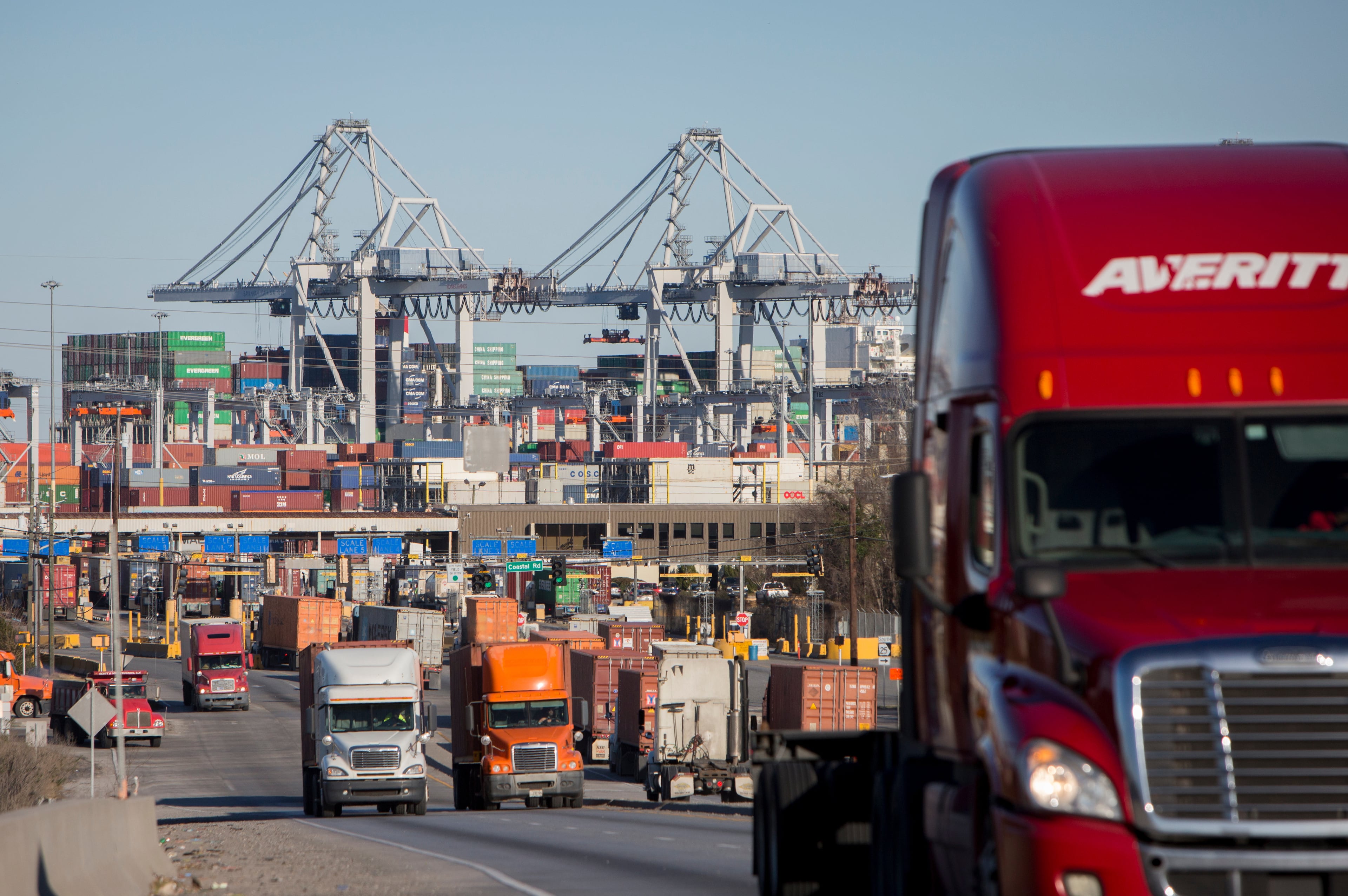Dockworkers’ labor strike threat averted at Georgia’s ports: What to know

SAVANNAH — Union dockworkers along the United States East Coast and Gulf Coast, including those at the Georgia Ports Authority marine terminals in Savannah and Brunswick, reached a labor agreement Wednesday ahead of a Jan. 15 deadline, averting a strike.
The new agreement remains tentative until ratified by union chapters organized under the International Longshoremen’s Association. Dockworkers went on strike for three days last October, the longshoremen’s first work stoppage since 1977.
“This is a win-win agreement that creates ILA jobs, supports American consumers and businesses, and keeps the American economy the key hub of the global marketplace,” negotiators said in a statement.
The agreement would give shippers and port operators leeway to introduce modernizing technology, a major negotiating point since the most recent labor contract expired last October, according to the Associated Press, citing an unnamed source. But in a concession to the union, they would have to hire new workers when they do, and full automation of port facilities is off the table.
Wages and automation are the major points of contention in the labor talks. Here’s what to know about the dispute and the strike.

Where does Georgia Ports Authority fit in?
The state-backed ports authority operates Georgia’s terminals but is not a member of the U.S. Maritime Alliance, a consortium of shipping companies, ocean carriers and port operators, and is not a stakeholder in the negotiations.
Authority CEO Griff Lynch shuttered Georgia’s ports during the October strike out of respect for the Georgia Ports Authority’s relationship with the International Longshoremen’s Association. About 2,500 ILA members work alongside more than 1,400 GPA personnel on the docks in Savannah and Brunswick.

What do ILA members do at the Georgia Ports?
Dockworkers load and unload cargo ships, working in conjunction with GPA-employed crane operators and other heavy-lift personnel. Georgia Ports ILA crews perform tasks in three key areas, each represented by a different union chapter.
The largest — the 1,600-member ILA 1414 — handles cargo at the Savannah terminals. ILA 1423, a chapter with 235 members, does likewise at the Port of Brunswick facilities. Separate union organizations, ILA 1475 in Savannah and ILA 1863 in Brunswick, perform clerk and checker duties, logging cargo as it moves between ship and shore and inspecting trucks as they enter and leave port properties.
Another ILA local, 2046, is made up of mechanics who repair shipping equipment, such as containers, trailer chassis and refrigerated units.
What is behind the pay dispute?
The ILA initially proposed a 77% pay bump for its members over the life of the next six-year contract, which would increase average pay from the current $39 an hour to $69 by 2030. The dockworkers revised the ask during the October strike, lobbying for a 61.5% pay bump that would push the average pay to $63 an hour or $131,000 a year — not including overtime — by 2030. U.S. Maritime Alliance leaders initially balked at that number and instead offered an increase of nearly 50%.
But once negotiations resumed after the start of the three-day work stoppage, the Maritime Alliance agreed to the pay demands. According to reports, the ILA average salary will increase by 62%. The bump exceeds the one West Coast dockworkers received a year ago. The labor agreement for those ports, which runs through 2027, caps average wages at $60 an hour or $124,800 a year.
Georgia union members argue the wages paid under the now-expired contract barely covered cost-of-living increases. Meanwhile, the Georgia Ports Authority saw its profits grow from $148 million in 2019, the first year of the expired contract, to $371.8 million in 2022 at the height of the pandemic surge. The GPA reported $261.7 million in profits in 2023.
“Even though the ILA’s members worked tirelessly during the pandemic to ensure that the nation’s commerce flowed ... employers refuse to compensate the ILA’s members fairly,” read a statement issued by the ILA at the start of the October strike. “Over the last several years, the net revenues of these companies have grown astronomically ... while the ILA members’ increases do not even cover the cost of inflation.”

What’s the deal with automation?
As in most industries, innovation has drastically changed the shipping sector, particularly in the size and scope of its workforce. The evolution on the docks began in the 1950s with the introduction of containers to move cargo but has accelerated in the digital age to the point where some ports, including one in the Netherlands and several in China, are fully automated.
The dockworkers’ unions have worked to slow the introduction of efficiency-focused technologies into port operations. The ILA has particularly held a hard line, pushing back against automations that eliminate jobs, such as optical scanners at facility gates and remote-operated cranes in container yards.
The use of camera technology at the gates of the Port of Mobile (Alabama) contributed to the breakdown of negotiations earlier this year.
And, on the West Coast, automation has advanced since a 2008 labor contract opened the door to technologies such as driverless trucks to move cargo around ports.
The GPA has implemented some technological advances in its operations but not at the expense of ILA jobs. Logistics software that tracks container movements is used in GPA facilities, with members of the clerks and checkers unions employing tablet computers to monitor loading and unloading data.
At the port gates, union members coordinate the flow. They say the importance of the roles goes beyond keeping track of cargo — the men and women on the ground look for damage to containers and truck chassis that could easily be missed by optical scanners.
“Automation of our nation’s ports should be a concern for everyone,” read an ILA statement issued in October 2024. “Robots do not pay taxes and they do not spend money in their communities.”
Automation is of critical concern in this contract because of the rapid advances in artificial intelligence. The ports that already use automation have humans who interface with software or remotely control equipment. AI could reduce those numbers as well.
Negotiators have yet to share information on how the tentative agreement addresses automation.
Could strike affect Georgia’s ports model?
Terminals in Georgia, South Carolina and North Carolina operate differently than other East Coast and Gulf Coast ports, with port authority staffers working alongside dockworkers in the loading and unloading of ships rather than the ILA handling all cargo movements. The GPA’s Lynch credits this so-called hybrid model for Georgia’s efficiencies and success.

The ILA has long challenged the operating structure. The 2012 labor agreement between the ILA and the U.S. Maritime Alliance leaders granted the ILA full control of any newly built container terminals at hybrid ports. A new terminal at the Port of Charleston (South Carolina) is fully staffed by the ILA, and Georgia is in the midst of retrofitting one facility, Ocean Terminal in Savannah, and planning the construction of a new venue across the Savannah River from Ocean Terminal.
The labor agreement could include new language regarding the future of hybrid ports.



